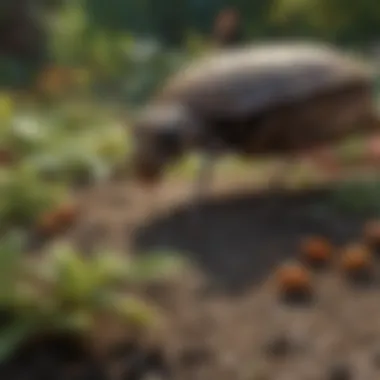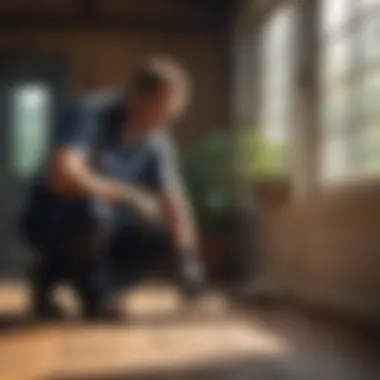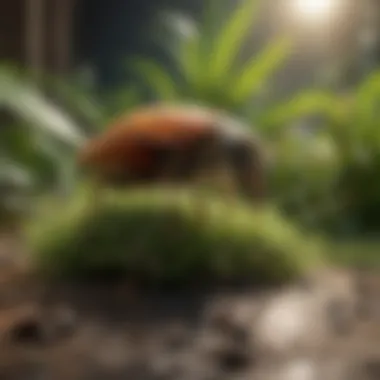Pest Control in Lafayette: Comprehensive Insights


Intro
Understanding pest control is crucial for homeowners in Lafayette, where environmental factors contribute to a diverse pest landscape. Managing pests requires not only effective methods but also a solid grasp of local species, signs of infestations, and sustainable practices. This article aims to provide a thorough overview, enabling informed decisions towards pest management and prevention.
Pest Identification
Identifying pests correctly is the first step toward effective management. Lafayette is home to various pests that can infiltrate homes, significantly impacting comfort and health.
Common Household Pests
In Lafayette, several pests are frequently encountered:
- Ants: Carpenter ants and sugar ants are common. They can damage wood structures and invade kitchens.
- Termites: Particularly problematic, they can cause severe structural damage if undetected.
- Rodents: Mice and rats seek shelter and food indoors, leading to sanitation issues.
- Cockroaches: These pests thrive in warm environments and can spread diseases.
- Spiders: Although not harmful in every instance, some species can be venomous and pose risks to families.
Signs of Infestation
Recognizing early signs of a pest problem can save time and expenses. Watch for:
- Droppings: Small pellets can indicate rodent activity, while insects may leave behind shed skins.
- Nesting materials: Shredded paper, insulation, or fabric might suggest mice or ants.
- Damage: Look for gnaw marks on wood or food packaging, which can indicate an infestation.
- Sounds: Noises at night, like scratching or scurrying, often suggest rodents are present.
Prevention Methods
Preventing infestations starts at home. Implementing specific strategies can greatly reduce risks.
Environmental Modifications
Make changes in your environment to deter pests. For example:
- Seal entry points: Inspect and repair gaps in windows, doors, and foundations.
- Proper drainage: Ensure that water does not accumulate around the home, reducing habitats for pests.
- Minimize clutter: Keep areas tidy to eliminate hiding spots, especially in garages and storage spaces.
Home Maintenance Tips
Routine maintenance is key in preventing pest issues:
- Regular inspections: Look for signs of pests during seasonal checks of your home.
- Yard maintenance: Keep shrubs and trees trimmed back from the house.
- Garbage management: Ensure bins are tightly covered to lessen attraction to food sources.
DIY Pest Control Solutions
For homeowners who prefer to tackle pest problems on their own, various do-it-yourself methods can be quite effective.
Natural Remedies
Utilizing natural solutions can be both effective and safer for the environment:
- Diatomaceous earth: This powder can help control insect populations without toxic chemicals.
- Essential oils: Oils like peppermint or tea tree can deter pests when used appropriately.
DIY Traps and Barriers
Creating traps and barriers is another preventive measure:
- Homemade traps: Use simple ingredients like sugar water to lure and trap ants or fruit flies.
- Physical barriers: Install mesh screens on vents and windows to keep pests out.
Always monitor your home for signs of infestation, and don't hesitate to call professionals if needed.
By applying these identification skills, prevention techniques, and DIY solutions, homeowners in Lafayette can effectively manage pests. A proactive approach not only protects the home and family but also fosters sustainable practices for long-term success.
Understanding Pest Control
Pest control is an essential aspect of maintaining a healthy and comfortable living environment for homeowners. In Lafayette, where diverse pests pose threats to residences, understanding pest control can greatly benefit individuals in preserving their homes. It involves not only addressing current infestations but also preventing future problems. Ignoring pest issues can lead to structural damage, health risks, and increased costs associated with extensive treatments.
Definition and Importance
Pest control refers to the management and regulation of unwanted organisms, commonly known as pests, that can negatively affect human health, property, and the environment. These pests can include insects, rodents, and other vermin that invade homes and gardens. The significance of pest control lies in its ability to safeguard property, ensure sanitation, and protect the wellbeing of inhabitants. Recognizing that pests can transmit diseases and cause significant harm underscores the necessity of an effective pest management strategy.
Types of Pest Control Methods
Understanding the various pest control methods is crucial for successful management. Each method has unique characteristics and applications, suitable for different situations. Here are the primary approaches:
Chemical Control
Chemical control involves the use of pesticides to eliminate or manage pest populations. This method is favored for its quick action and effectiveness in large-scale infestations. The key characteristic of chemical control is its ability to provide immediate results. Pesticides can be formulated to target specific pests without harming non-target organisms. However, its use can pose risks to humans and pets, as well as potential environmental concerns regarding residue and contamination.


Biological Control
Biological control employs natural predators or parasites to reduce pest populations. This method is based on ecological principles and promotes a balanced environment. The key strength of biological control is its sustainability; it does not depend on synthetic chemicals, making it an eco-friendly choice. Nonetheless, the effectiveness can vary depending on environmental conditions and the specific pest involved. It often requires a longer time to see significant results compared to chemical methods.
Cultural Control
Cultural control focuses on modifying practices to discourage pest establishment and proliferation. This might include crop rotation, proper sanitation, and varying planting times. The primary advantage of cultural control is its preventive nature, which reduces the likelihood of pest problems before they arise. While it often requires more effort and planning, the long-term benefits include reduced dependency on chemical treatments.
Mechanical Control
Mechanical control relies on physical tools and techniques to manage pests. Common methods include traps, barriers, and hand-picking. The key characteristic of mechanical control is its straightforward approach, which often allows immediate reduction of pest populations without chemicals. While it is safe for humans and the environment, its effectiveness may be limited in large infestations and often requires consistent monitoring to maintain control.
Understanding these methods provides homeowners with the tools to approach pest issues strategically.
In summary, each pest control method has its unique place in the broader context of managing vermin in Lafayette. Homeowners should consider the benefits and drawbacks of each method and choose the approach that aligns with their specific needs and values.
Pest Landscape in Lafayette
The pest landscape in Lafayette is essential to understand for effective pest management. This section examines the types of pests commonly found in the region, as well as their seasonal activity. Knowing what pests to expect can help homeowners prepare and respond effectively. It is important for maintaining the integrity of homes and ensuring a healthy environment.
Common Pests in Lafayette
Common pests in Lafayette encompass a range of species that may pose threats to health and property. Each pest brings its unique challenges. Understanding these pests aids in implementing proper control strategies.
Ants
Ants are some of the most prevalent household pests. They are social insects, often found in large colonies. Their ability to invade homes in search of food makes them a significant concern for residents. Ants tend to leave behind pheromone trails, which can attract more ants. This highway-like behavior increases chances of infestation over time. They can be both an annoyance and a risk due to potential contamination of food supplies.
Termites
Termites are known as silent destroyers due to their potential to cause extensive damage to wooden structures. They feed on cellulose found in wood, paper, and other materials. Termite infestations can be costly, often going undetected until significant damage occurs. Given Lafayette's property types, the presence of termites is a genuine threat to homeowners. Monitoring and early detection are crucial steps in mitigating their impact.
Rodents
Rodents, including mice and rats, are opportunistic feeders. They can enter homes through small openings, seeking shelter and food. Rodents can cause significant damage, chewing through wires and insulation. They are also known carriers of diseases. Their ability to reproduce quickly can lead to large populations if not dealt with promptly. Understanding signs of rodent presence can help in early intervention.
Bees
Though bees play an essential role in pollination, they can become a nuisance when they establish hives near homes. Unlike wasps, which can be more aggressive, bees tend to be more docile unless provoked. However, they can pose a risk to individuals with allergies. It's crucial to identify them correctly and manage them safely without unnecessary extermination, as they are vital for ecosystem health.
Seasonal Pest Activity
Seasonal changes influence pest behavior and activity patterns. Each season presents unique challenges and opportunities for pest control.
Spring
In spring, many pests emerge from dormancy. Warmer temperatures trigger ants and bees to become more active. Homeowners should be prepared to manage early infestations. Additionally, termites become active as they search for new sources of food, making spring an ideal time for inspections.
Summer
Summer heats can bring an influx of pests. Ants are particularly active, foraging for food, and may invade homes in higher numbers. Rodents also seek shelter in cooler areas. The combination of increased moisture and warmth creates a conducive environment for pests to thrive. Homeowners must stay vigilant during this time.
Fall
As temperatures start to drop, many pests prepare for winter. Rodents often seek indoor shelters for warmth as they prepare for colder months. Additionally, some pests may begin to congregate in large numbers as they look for nesting areas. This transition period is critical for preventative measures to avoid infestations.
Winter
Winter can see a decline in activity for some pests; however, this does not mean they are gone. Rodents may remain active indoors while ants and bees become dormant. Some pests may still invade homes seeking food and shelter. Understanding this dynamic can help homeowners maintain their properties effectively during the cold months.
Identifying Pest Problems
Understanding how to identify pest problems is fundamental for effective pest control. Early detection is key to prevent pests from causing irreversible damage. Homeowners should be aware of what signs indicate a pest presence in order to take prompt action. By knowing the signs of infestation, you can mitigate damage and keep your home safe.
Signs of Infestation
Detecting an infestation early allows for more effective management. Identifying the signs can save time and prevent costly damage. The three most common indicators are droppings, nesting materials, and damage to property.
Droppings
Droppings are often the clearest sign of a pest issue. Each type of pest leaves behind distinct droppings. For example, rat droppings are typically about half an inch long, while cockroach droppings are smaller and often resemble dark specks. Recognizing these droppings is important. They indicate the presence of pests and can give clues about the type present. This is a beneficial indication of potential pest activity in your home. Each droppings type can lead to specific control methods that may be more effective.


Nesting Materials
Nesting materials are another telltale sign of pests. These can include shredded paper, fabric, or even dead plant matter. Oftentimes, these materials are found in hidden corners of your home, such as attics or basements. Understanding the significance of these materials can assist in controlling a larger problem. The presence of nesting materials points towards an established infestation, which may require more comprehensive intervention than just a surface-level approach. It can also provide insight into the species of pest, which is vital for correct identification.
Damage to Property
Damage to property can manifest in various forms, such as chewed wires, holes in walls, or gnawed furniture. This damage is not merely cosmetic; it may lead to structural issues if left unchecked. Observing these damages is critical, as they highlight both the extent of the infestation and the urgency for management. When property damage occurs, the repairs can be costly, and the pest problem may worsen. Therefore, promptly addressing signs of damage is important.
Correct Identification Techniques
To effectively manage pests, correct identification techniques are essential. Utilizing the right methods for identification minimizes guesswork and enhances the likelihood of successful pest control. The most effective strategies include visual inspection, tracking techniques, and consulting available resources.
Visual Inspection
Visual inspection serves as a first line of defense in identifying pests. Walking through your home and checking common hiding spots can reveal signs like droppings or damage. This method is straightforward and requires no special tools. However, it may not always uncover hidden pests. Regular inspections can keep homeowners aware of potential infestations before they escalate.
Tracking Techniques
Tracking techniques involve monitoring for pest activity through various means. This can include setting up traps or bait stations to catch pests or employing professional tracking devices. These techniques often provide more concrete evidence of an infestation compared to visual inspections alone. However, they may require investment in equipment or professional assistance to be done correctly.
Consulting Resources
When unsure, consulting resources can provide valuable information. This may include reaching out to local pest control experts or using online databases to identify species. Resources can offer in-depth knowledge on what signs to look out for and how to treat specific infestations. The primary downside is that this may require more time compared to self-inspection, but the results can be substantially more accurate.
Identifying pest problems accurately contributes significantly to effective management. Early identification not only helps in controlling an infestation but also protects the integrity of your home. By understanding the signs and employing effective identification techniques, homeowners can take proactive steps in pest management.
DIY Pest Control Solutions
DIY pest control solutions offer homeowners effective ways to manage pest problems without relying solely on professional services. These methods can be cost-efficient and empower individuals to take charge of their living environments. However, it is significant to balance effectiveness with safety and environmental considerations.
Preventive Measures
Preventive measures form the first line of defense in pest management. They focus on minimizing the risk of infestations through behavior modifications and basic maintenance.
Sealing Entry Points
Sealing entry points is a crucial aspect of preventive pest control. This involves identifying and closing gaps or cracks in the exterior of a home. Common places to check include windows, doors, and utility lines. This method's key characteristic is its ability to physically block pests from entering living spaces. It is a beneficial choice as it provides a barrier against various pests, including rodents and insects. The unique feature of sealing entry points is that it does not rely on chemicals, making it both safe for families and pets. On the downside, it can be time-consuming to conduct a thorough inspection and seal every possible access point.
Proper Waste Management
Proper waste management is another effective preventive method. This entails storing food in sealed containers and ensuring rubbish bins are tightly closed. Its key characteristic is its simplicity and direct impact on reducing food sources available for pests. This choice is beneficial as it helps in minimizing the attraction of pests like ants and cockroaches. A unique feature of proper waste management is the routine it creates; with consistent practice, homeowners can significantly lower pest risk. However, neglecting waste can lead to rapid infestations, which highlights the need for ongoing diligence.
Maintaining Clean Surroundings
Maintaining clean surroundings is essential in DIY pest control. This means regular cleaning of both indoor and outdoor areas, including gardens and patios. Its key characteristic is the promotion of a pest-free environment through hygiene. This is a popular choice for many homeowners as it actively discourages pests from making themselves comfortable. The unique feature of this practice lies in its preventive nature; a clean space is less inviting to pests. However, it requires continuous effort, as even a small lapse in cleanliness can provide an opportunity for pests to invade.
Homemade Remedies
Homemade remedies are natural solutions that homeowners can create using everyday ingredients. They cater to those who prefer eco-friendly practices over chemical pesticides.
Essential Oils
Essential oils are a popular homemade remedy in pest control. They can repel various pests due to their strong scents. The key characteristic of essential oils is their fragrance, which many pests find unpleasant. This is a beneficial choice for those looking for non-toxic options. A unique feature is that essential oils can also provide pleasant aromas in the home, making them double-duty solutions. However, their effectiveness may vary based on concentration and pest type.
Diatomaceous Earth
Diatomaceous earth is another effective homemade remedy. Composed of tiny fossilized aquatic organisms, it works by dehydrating insects that come into contact with it. Its key characteristic is its abrasive nature, which can kill pests like ants and bedbugs. This branded substance is a beneficial option as it is safe for humans and pets when used correctly. The unique feature of diatomaceous earth is its longevity; it remains effective as long as it stays dry. However, it can be less effective in humid conditions, and care must be taken during application to avoid inhalation.
Natural Repellents
Natural repellents, made from household items or plants, are also a part of DIY pest control. They often contain ingredients like vinegar or garlic, which pests typically avoid. Their key characteristic is the use of nature-derived ingredients, aligning with sustainable practices. This is a beneficial approach for eco-conscious homeowners. A unique feature is their availability; most ingredients may already be at home. While natural repellents are generally safer, they may require frequent reapplication for maximum effectiveness.
Professional Pest Control Services
Addressing pest issues effectively often requires the expertise of professional pest control services. These specialized companies are trained to identify not just the pests residing in a home but also the weaknesses that allow them entry. The importance of hiring professionals lies in their ability to develop comprehensive treatment plans tailored to the unique challenges of each situation. They can offer solutions that go beyond the average household methods, targeting root causes and implementing sustainable eradication techniques.
When to Seek Professional Help
There are times when pest control becomes more complex than a simple DIY approach. Homeowners should consider professional help when:
- Infestations are Widespread: Large populations of pests like termites or rodents might escape basic control methods.
- Health Risks are Present: Some pests carry diseases or allergens, making their presence a health concern.
- Damage to Property: Significant destruction caused by pests can lead to costly repairs if not handled promptly.
- Failed DIY Attempts: If initial efforts do not yield results, it’s time to consult a professional.


Choosing the Right Service Provider
Selecting a pest control service is crucial to ensuring effective results. Here are key aspects to assess:
Credentials
Credentials are an essential aspect to evaluate when choosing a pest control provider. Certification from recognized organizations assures that the service follows industry standards. Technicians with proper training possess the knowledge necessary to handle various pest situations efficiently. A recognized credential gives peace of mind to homeowners, ensuring that the service they receive is based on proven methods. The unique feature of having certified professionals is their updated training on the latest techniques and pest behavior, which can enhance the effectiveness of treatments implemented.
Reviews
Reviews from past customers provide valuable insights into the service provider’s performance. They reflect the reliability and quality of the service you can expect. Positive reviews are beneficial because they indicate a track record of successful pest management solutions. Checking online reviews can highlight unique experiences from other clients regarding effectiveness and customer service. However, one should also be aware of the occasional disparity between reviews and real experiences, emphasizing the need for careful analysis.
Service Options
Service Options refer to the variety of approaches offered by pest control companies. Many providers offer tailored plans based on the specific needs of a household. For example, while some might specialize in immediate extermination, others focus on long-term management strategies. The key appeal of diverse service options is their adaptability; they give homeowners flexibility based on their preferences or specific pest issues they are facing. The downside could be the complexity of understanding which method is most suitable for individual situations. A clear understanding of available services enhances a homeowner's ability to make informed decisions regarding pest management.
In summary, hiring professional pest control services enables homeowners to address infestations more effectively and sustainably. Understanding when to seek help, choosing the right provider, and evaluating the credentials, reviews, and service options are critical steps in ensuring a pest-free environment.
Sustainable Pest Management Practices
Sustainable pest management practices are crucial in maintaining a balanced ecosystem while effectively managing pest populations. These practices emphasize minimal environmental impact, making them a favorable choice for many homeowners in Lafayette. Understanding sustainable methods can lead to long-term solutions that are not just effective but also kinder to the environment. Homeowners can cultivate a habitat that discourages pest infestation without resorting to harmful chemicals.
Eco-friendly Pest Control Options
Natural Pesticides
Natural pesticides are derived from plants and minerals rather than synthetic chemicals. This characteristic makes them safer for both humans and pets. One popular type of natural pesticide is neem oil, which is effective against a variety of insects while still being biodegradable. The advantage lies in their reduced toxicity; however, they may be less potent than traditional pesticides, requiring more frequent applications to maintain effectiveness.
Encouraging Beneficial Insects
Encouraging beneficial insects in your garden is a sound strategy for pest control. Predators such as ladybugs and lacewings feed on common garden pests, thus naturally regulating their populations. The key characteristic of this approach is that it promotes biodiversity and reinforces the health of the ecosystem. While providing a habitat for these insects can take some effort, the long-term benefits can be significant. However, reliance on this method may not suffice in severe infestations.
Organic Gardening Techniques
Organic gardening techniques focus on growing plants without synthetic fertilizers or pesticides. This method is beneficial because it promotes sustainable practices while producing healthy food free from harmful residues. Techniques like crop rotation and companion planting enhance soil health and prevent pest issues. The unique feature of organic gardening is its holistic approach. However, it may require more time and knowledge to implement successfully compared to conventional practices.
Legislation and Compliance
Legislation plays an important role in pest control management, ensuring practices are safe and environmentally friendly. Compliance with local regulations is key for residents, as it protects not only the community but also the surrounding ecology. Understanding these laws can prevent costly fines and enhance the effectiveness of pest control efforts.
Local Regulations
Knowledge of local regulations regarding pest control helps homeowners make informed decisions. These regulations often dictate which substances can be used and how to apply them responsibly. This understanding fosters community awareness and consistency in pest management strategies. Not adhering to these rules may lead to negative consequences such as environmental harm or health risks.
Environmental Impact Assessments
Environmental impact assessments are vital for evaluating the potential consequences of pest management strategies. These assessments help to identify any negative effects on local wildlife and plant species before implementation. The significance lies in ensuring sustainable practices balance pest control with ecological integrity. While assessments require time and resources, the long-term benefits in preserving the ecosystem justify the effort.
End and Summary
In concluding this comprehensive overview of pest control in Lafayette, it is critical to emphasize the value of understanding pest management. Knowing the pest landscape aids homeowners in identifying potential problems early. Hence, it can prevent infestations from escalating into larger issues that could affect both health and property.
Additionally, the article highlights various pest control methods. Each method’s effectiveness varies, depending on the pest type and the environment. Homeowners must choose solutions that not only address the immediate issue but also consider longer-term impacts, especially regarding sustainability.
Recap of Key Information
Throughout the article, several key points emerged:
- There is a diverse array of pests common to Lafayette, including ants, termites, and rodents.
- Seasonal changes influence pest activity, making it necessary for homeowners to stay alert during different times of the year.
- DIY solutions can be effective but may have limitations that warrant professional intervention.
- Sustainable practices are increasingly important for keeping pest numbers in check without harming the environment.
- Understanding local regulations ensures compliance and promotes responsible pest management strategies.
This synthesis not only serves as a guide for immediate issue resolution but also as a foundational resource for ongoing pest control education.
Future Trends in Pest Control
As the pest control industry continues to evolve, several noteworthy trends are shaping the future landscape.
Technological Advancements
Technological advancements in pest control emphasize tools that enhance efficiency. Smart pest control systems use sensors and IoT devices to monitor pest activity in real-time. This real-time data helps in making informed decisions about control measures. One key characteristic of these systems is their ability to integrate with mobile applications. This innovative feature allows homeowners to manage pest concerns from anywhere, increasing convenience.
Moreover, the use of drones for surveying and targeting pest infestations is gaining traction. Drones can cover large areas quickly, identifying problem zones without extensive manual labor. Although there are challenges like costs and the need for skilled operators, the long-term benefits include reduced chemical use and a more strategic approach to pest control.
Public Awareness Initiatives
Public awareness initiatives focus on educating homeowners about effective pest management strategies. These programs teach individuals to recognize signs of infestation and employ preliminary preventive measures. One prominent feature of such initiatives is community involvement. This collaboration often leads to neighborhood-level pest control efforts, fostering a unified approach.
Furthermore, increased awareness promotes responsible chemical usage, reducing environmental impact. Discussing the importance of these initiatives highlights their contribution to effective pest control practices. Homeowners not only gain valuable information but also become part of a community effort. However, these programs may face challenges, such as misinformation or lack of participation.
In summary, as Lafayette’s pest control landscape evolves, embracing technology and community education will play pivotal roles in shaping a safer and healthier environment.















